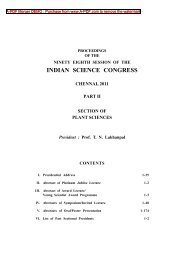sustainable use of biological diversity.pdf - India Environment Portal
sustainable use of biological diversity.pdf - India Environment Portal
sustainable use of biological diversity.pdf - India Environment Portal
Create successful ePaper yourself
Turn your PDF publications into a flip-book with our unique Google optimized e-Paper software.
Sustainable <strong>use</strong> <strong>of</strong> <strong>biological</strong> <strong>diversity</strong> in socio-ecological production landscapes<br />
and seed collection. Organic fertilizer is obtained<br />
from family livestock or from livestock belonging to<br />
other families <strong>of</strong> the community, or from the forest.<br />
This method <strong>of</strong> obtaining fertilizer is only incorporated<br />
in potato cultivation, while the cultivation <strong>of</strong><br />
oca and papalisa, as well as the grains, planted in the<br />
same space in the next agricultural cycle and the one<br />
following that, benefit from the residual effect <strong>of</strong> this<br />
initial fertilization.<br />
6. Conclusions<br />
The Potato Park, as an example <strong>of</strong> revitalising the<br />
ayllu cultural landscape, has generated social, cultural,<br />
environmental, economic and political benefits to<br />
the communities. Communities have strengthened<br />
their intercommunity networks, generating synergies<br />
through creating intercommunity groups. These<br />
include the economic collectives, and the Association<br />
<strong>of</strong> the Communities <strong>of</strong> the Potato Park, bringing<br />
together all <strong>of</strong> the communities for decisionmaking.<br />
Women, as a major interest group have<br />
a leading role in implementing action in the Park,<br />
and their participation in decision-making is being<br />
strengthened currently. Similarly through participation<br />
in economic collectives they also contribute to<br />
family economies. Culture is strengthened through<br />
implementation <strong>of</strong> the Potato Park beca<strong>use</strong> it reinforces<br />
the role <strong>of</strong> local culture through institutions,<br />
promoting regeneration <strong>of</strong> community identities.<br />
Other positive impacts include the restitution <strong>of</strong> genetic<br />
variability <strong>of</strong> native potato crops, repatriation<br />
and restoration <strong>of</strong> the cultural landscape; agro-ecotourism<br />
generating income and incentives for conservation<br />
and the promotion <strong>of</strong> regional ordinances.<br />
This study was conducted as part <strong>of</strong> the program activities<br />
<strong>of</strong> the Satoyama Initiative, United Nations<br />
University Institute <strong>of</strong> Advanced Studies.<br />
References<br />
Argumedo, A (2008) The Potato Park, Peru: Conserving agrobio<strong>diversity</strong><br />
in an Andean Indigenous Biocultural Heritage Area,<br />
in Amend, T., Brown, J., Kothari A., Phillips, A., Stolton, S. eds.<br />
Portected Landscapes and Agrobio<strong>diversity</strong> Values. Vol 1 in the<br />
series, Protected Landscapes and Seascapes, IUCN & GTZ. Kaspareg<br />
Verlag, Heidelberg.<br />
Brown, J., Mitchell, N. 2000. Culture and nature in the protection<br />
<strong>of</strong> Andean landscapes Mountain Research and Development,<br />
20(3) 212-217.<br />
CIP 2008. http://www.cipotato.org/pressroom/press_releases_detail.asp?cod=23<br />
Guillet, D. 1983. Toward a cultural ecology <strong>of</strong><br />
mountains: The central Andes and the Himalayas compared Current<br />
Anthropology 24(5) 561-574<br />
Godoy, R. 1991. The evolution <strong>of</strong> common-field agriculture in the<br />
Andes: A hypothesis, Society for Comparative Study <strong>of</strong> Society<br />
and History, Vol 33, No. 2 pp. 354-414Nickel, C. 1982. The semiotics<br />
<strong>of</strong> Andean terracing Art Journal, Fall edition<br />
Holling, C. S. (Ed.). (1978). Adaptive environmental assessment<br />
and management. New York: John Wiley.<br />
Phillips, A, (2002). Management Guidelines for IUCN Category<br />
V Protected Areas Protected Landscapes/Seascapes. World Commission<br />
on Protected Areas. Best Practice Protected Area Guildeline<br />
Serise No. 9, IUCN.<br />
Zimmerer, K. S. (2002) Common field agriculture as a cultural<br />
landscape <strong>of</strong> Latin America: development and history in the geographical<br />
customs <strong>of</strong> resource <strong>use</strong>. Journal <strong>of</strong> Cultural Geography,<br />
19.2, 37(27)<br />
90
















